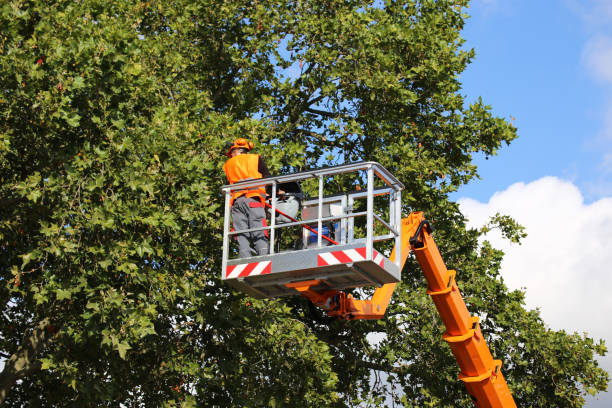Regarding tree service operations, various hazards can pose significant risks to workers and property. Each scenario requires careful consideration and mitigation strategies, from the dangers of tree felling to the potential threat of electrical lines.
Equipment malfunction is another critical aspect to address, as is the risk of falling branches during tree removal. Additionally, encountering wildlife adds an unpredictable element to the job. Understanding these common hazards is crucial, but knowing how to mitigate them effectively is essential for ensuring a safe and successful tree service operation.
Tree Felling Hazards
Tree felling, the process of cutting down trees, poses significant hazards to workers and property if not managed with proper caution and expertise. Safety precautions are paramount in mitigating these risks. Workers involved in tree felling must undergo appropriate training to ensure they have the necessary skills and knowledge to perform the task safely. Training should cover aspects such as identifying potential hazards, correct operation of equipment like chainsaws, and emergency procedures in case of accidents.
Safety precautions during tree felling include conducting a thorough site assessment to identify potential risks such as uneven terrain, dead branches, or nearby structures. Workers should also use the appropriate personal protective equipment (PPE), such as helmets, gloves, and safety glasses, to minimize the risk of injury. Additionally, establishing a transparent communication system among workers and ensuring a safe distance from falling trees are essential safety measures to prevent accidents and injuries during tree-felling operations.
Electrical Line Risks
What precautions should be taken to mitigate the risks associated with electrical lines during tree service operations? Safety gear and thorough risk assessment are essential in preventing accidents when working near electrical lines. Before starting any tree service near power lines, it is crucial to identify the location of all electrical lines on the property. A detailed risk assessment should determine the safest tree removal or trimming approach near power lines.
When working around electrical lines, tree service professionals must wear appropriate safety gear, such as insulated gloves, boots, and helmets, to minimize the risk of electrical shock.
It is also essential to maintain a safe distance from power lines and never attempt tree work during adverse weather conditions, such as strong winds or storms, which can increase the likelihood of contact with power lines. By prioritizing safety gear and conducting thorough risk assessments, tree service workers can mitigate the dangers associated with electrical lines and ensure a safe working environment.
Equipment Malfunction Dangers
Thorough maintenance protocols and regular inspections are paramount to mitigate the risks associated with equipment malfunction during tree service operations. Preventive maintenance ensures that tree service equipment functions correctly and safely.
Regularly scheduled maintenance checks help identify potential issues before they escalate into dangerous malfunctions. Implementing strict safety protocols is also essential in minimizing equipment-related hazards. This includes providing comprehensive training to all personnel on safely operating and maintaining the equipment and emphasizing the importance of following manufacturer guidelines.
In addition to preventive maintenance and safety protocols, a system for reporting and promptly addressing equipment malfunctions is crucial. Encouraging open communication among team members to report any irregularities or concerns with the equipment can help prevent accidents and injuries.
Tree service companies can effectively mitigate the dangers associated with equipment malfunctions by prioritizing preventive maintenance, adhering to safety protocols, and fostering a culture of proactive communication.

